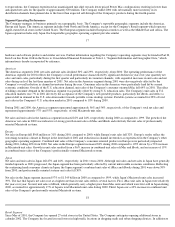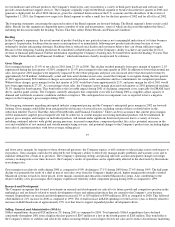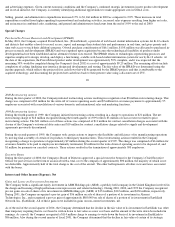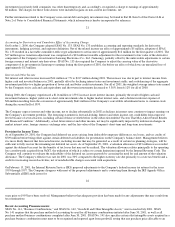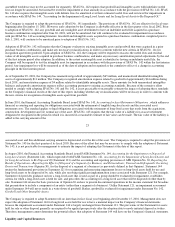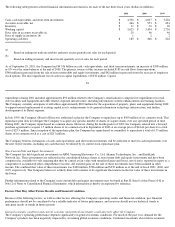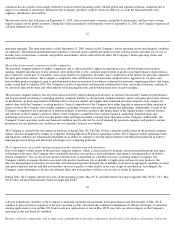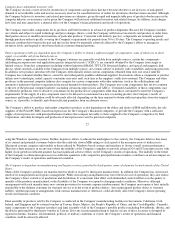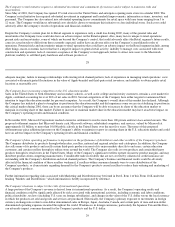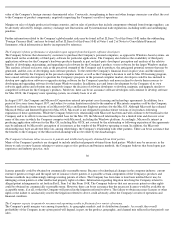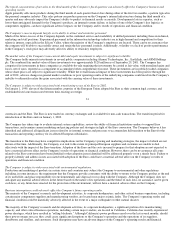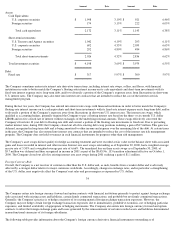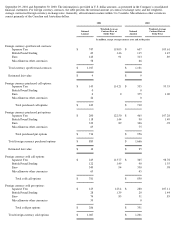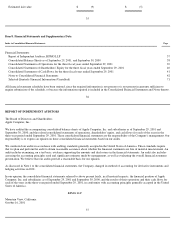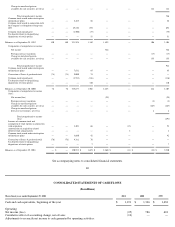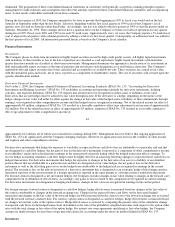Apple 2001 Annual Report Download - page 24
Download and view the complete annual report
Please find page 24 of the 2001 Apple annual report below. You can navigate through the pages in the report by either clicking on the pages listed below, or by using the keyword search tool below to find specific information within the annual report.
value of the Company's foreign currency denominated sales. Conversely, strengthening in these and other foreign currencies can effect the cost
to the Company of product components, negatively impacting the Company's results of operations.
Margins on sales of Apple products in foreign countries, and on sales of products that include components obtained from foreign suppliers, can
be adversely affected by foreign currency exchange rate fluctuations and by international trade regulations, including tariffs and antidumping
penalties.
Further information related to the Company's global market risks may be found in Part II, Item 7A of this Form 10-K under the subheading
"Foreign Currency Risk" and may be found in Part II, Item 8 of this Form 10-K at Notes 1 and 2 of Notes to Consolidated Financial
Statements, which information is hereby incorporated by reference.
The Company's future performance is dependent upon support from third-party software developers.
The Company believes that decisions by customers to purchase the Company's personal computers, as opposed to Windows-based systems, are
often based on the availability of third-party software for particular applications. The Company also believes the availability of third-party
application software for the Company's hardware products depends in part on third-party developers' perception and analysis of the relative
benefits of developing, maintaining, and upgrading such software for the Company's products versus software for the larger Windows market.
This analysis is based on factors such as the perceived strength of the Company and its products, the anticipated potential revenue that may be
generated, and the costs of developing such software products. To the extent the Company's financial losses in prior years and the minority
market share held by the Company in the personal computer market, as well as the Company's decision to end its Mac OS licensing program,
have caused software developers to question the Company's prospects in the personal computer market, developers could be less inclined to
develop new application software or upgrade existing software for the Company's products and more inclined to devote their resources to
developing and upgrading software for the larger Windows market. In addition, past and future development by the Company of its own
software applications and solutions may negatively impact the decision of software developers to develop, maintain, and upgrade similar or
competitive software for the Company's products. Moreover, there can be no assurance software developers will continue to develop software
for Mac OS X, the Company's new operating system, on a timely basis or at all.
In August 1997, the Company and Microsoft Corporation entered into patent cross licensing and technology agreements. In addition, for a
period of five years from August 1997, and subject to certain limitations related to the number of Macintosh computers sold by the Company,
Microsoft will make future versions of its Microsoft Office and Internet Explorer products for the Mac OS. Although Microsoft has released
Microsoft Office and Internet Explorer for Mac OS X, Microsoft is not obligated to produce future versions of its products following
expirations of these agreements. While the Company believes its relationship with Microsoft has been and will continue to be beneficial to the
Company and to its efforts to increase the installed base for the Mac OS, the Microsoft relationship is for a limited term and does not cover
many of the areas in which the Company competes with Microsoft, including the Windows platform. Accordingly, Microsoft's interest in
producing application software for the Mac OS, including Mac OS X, not covered by the relationship or following expiration of the agreements
may be influenced by Microsoft's perception of its interests as the vendor of the Windows operating system. In addition, the Microsoft
relationship may have an adverse effect on, among other things, the Company's relationship with other partners. There can be no assurance that
the benefits to the Company of the Microsoft relationship will not be offset by the disadvantages.
The Company's business relies on access to patents and intellectual property obtained from third parties.
Many of the Company's products are designed to include intellectual property obtained from third parties. While it may be necessary in the
future to seek or renew licenses relating to various aspects of its products and business methods, the Company believes that based upon past
experience and industry practice, such
30
licenses generally could be obtained on commercially reasonable terms. Because of technological changes in the computer industry, current
extensive patent coverage, and the rapid rate of issuance of new patents, it is possible certain components of the Company's products and
business methods may unknowingly infringe existing patents of others. The Company has from time to time been notified that it may be
infringing certain patents or other intellectual property rights of others. Information regarding litigation involving the Company related to
alleged patent infringement is set forth in Part I, Item 3 of this Form 10-K, The Company believes that any necessary patent or other rights
could be obtained on commercially reasonable terms. However, there can be no assurance that the necessary licenses would be available on
acceptable terms, if at all, or that the Company will prevail in the litigation referred to above. The failure to obtain necessary licenses or other
rights or the failure to satisfactorily resolve the litigation referred to above could adversely affect the Company's results of operations and
financial condition.
The Company expects its quarterly revenues and operating results to fluctuate for a variety of reasons.
The Company's profit margins vary among its products, its geographic markets, and its distribution channels. As a result, the overall
profitability of the Company in any given period will depend, in part, on the product, geographic, and channel mix reflected in that period's net
sales.



